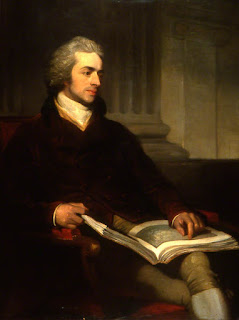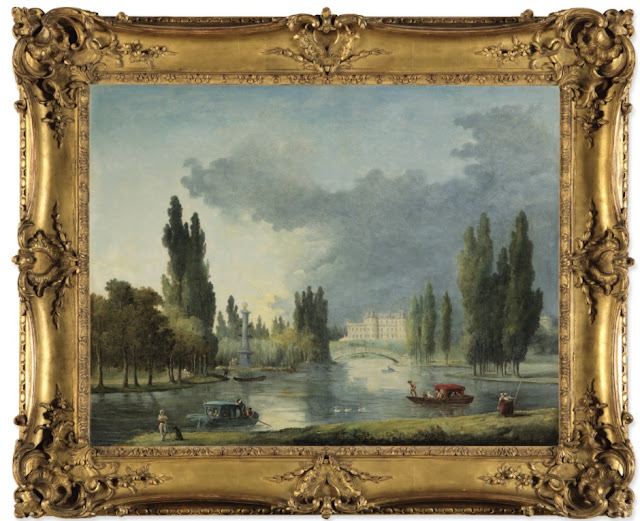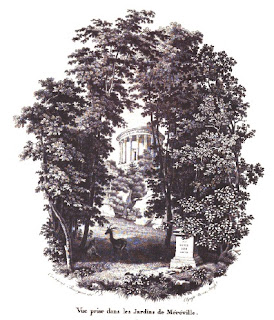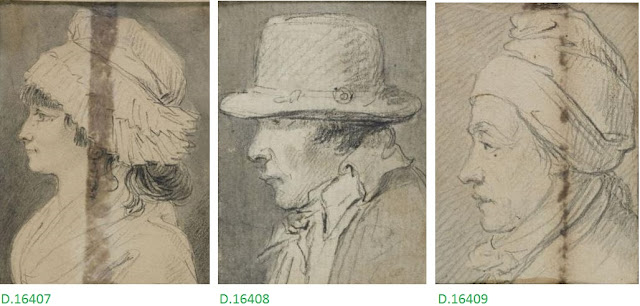We now come to 1793, the year of the Terror. Morice mentions the assassination of Le Pelletier de Saint-Fargeau on the eve of the King's execution, in January 1793. He personally had visited Le Pelletier in the place Vendôme on several occasions on legal business and recalled some disturbing ornaments in his reception room - a huge jewel on the chimney breast and, in lieu of a mantle clock, a glass dome housing a miniature guillotine with all its accessories.
The execution of Louis XVI
By this time Morice was enrolled in the National Guard, which became increasingly dominated by radical Revolutionaries. Morice twice found himself on guard at the Temple during Louis XVI's trial when his lawyers Malesherbes and de Sèze came to confer with him. He did not manage to see the King himself but, by an odd set of circumstances, he witnessed his execution:
On the day of the King's execution, my company of National Guard was required, like the rest, to furnish a certain number of guardsmen to attend and ensure good order. Only two or three individuals volunteered, so lots were drawn and I was among those chosen. I had never been to an execution of any sort before. Those who know my character, can imagine the effect that this one had on me. I managed at first to put on a brave face. But when the victim mounted the scaffold and had his coat removed, I could take no more; I found that I had fainted and I came round only when one of my companions offered me a few drops of eau-de-vie he had acquired from a nearby canteen. By then it was all over. Fortunately for me, I was surrounded by honest men who, like me, took little pleasure in the occasion.
The journée of 31st May
After the death of Louis XVI, the Revolutionary factions fell one by one. Morice, by this time under arms, now found himself a reluctant participant in the journée of 31st May, which accompanied the proscription of the Girondin deputies.
By the first days of May 1793 the National Convention had become the puppet of the Paris Commune; it was the Commune that really ruled. The Commune was dominated in turn by the Jacobin club. The Revolutionary Committees of the 48 sections were its eyes and ears. It seems that the Commune had experienced opposition from the Girondins. A campaign of petitioning was orchestrated in the Convention, but it was finally planned to strike a decisive blow. Thus the journée of the 31st May was organised.
At daybreak the tocsin sounded; the inhabitants of Paris were ordered to congregate in prominent locations in the sections. The notary that I worked for responded to the call, with his entire household, the more promptly since he had already been blacklisted by the Revolutionary Committee of the Bonnet Rouge section. Only the youngest pupil was left behind to receive callers in our absence.
All men able bear arms were ordered to assemble in the garden of the hospice des Petites-Maisons, rue de Sèvres. Guns were distributed to some, pikes and sabres to others. Some were forced to content themselves with sticks. We then set off at a brisk march, preceded by a cannon with its fuse already alight. We took the shortest route to the garden of the Tuileries, where we arrived before seven o'clock. We were assigned a position on the terrace, beside the water. It was cold - there had been hail in the night and conditions were still freezing at that hour of the morning.
The other terraces, the adjacent bridges, the place du Carrousel, the place de la Concorde and most of the boulevards were suddenly occupied, as if by magic, by armed bands like ours. Professionals reckon that there were more than 100,000 men under arms.
What was the purpose of this expedition? What were we going to do? We asked these questions to anyone whose appearance inspired confidence, but no-one could give us a reply. It was only two or three days later that we finally discovered the answer to the riddle....
Who would have believed that all these carefully planned measures were to prove a complete waste of time? We stayed shivering on our miserable terrace from seven in the morning until midnight...Such were our exploits on the 31st May and 2nd June. But so it was that the Girondin party was destroyed.
Guarding the Temple prison
Again as a National Guardsman, Morice was stationed at the gate of the Temple prison where Marie-Antoinette, Madame Elisabeth, Louis XVII and Madame Royale were imprisoned. He was able to catch a memorable glimpse of the royal family.
On the first occasion, the gate stayed open for an hour or so, and I was able to see them, since the screen which was normally positioned inside the gate had become displaced. The municipal officer on duty seemed less unpleasant that most of his colleagues. He allowed them as much liberty as his duty permitted. The dauphin, who was no more than six years old at that time, jumped and ran around in the small space. He came up close to me and seemed ready to respond to the advances I made in the hope of amusing him. But Madame Elisabeth took him by the hand and led him back inside the apartment.
Care was taken to choose guns which were smaller than normal when patrolling the Temple tower, as the roof was so low. The one given to me was also very light; it wasn't even loaded; I admit, to my shame, that I didn't trouble overmuch with my military duties. A book in my hand seemed much less inconvenient than a gun over my shoulder and, when my superior officers were not looking, I passed my patrol reading. That was how I was peacefully occupied that day, when the dauphin approached me. My gun, leaning against the wall, seemed to catch his attention. He dared not touch it, but he seemed drawn to it. I was about to show it to him when his aunt fetched him away.










































